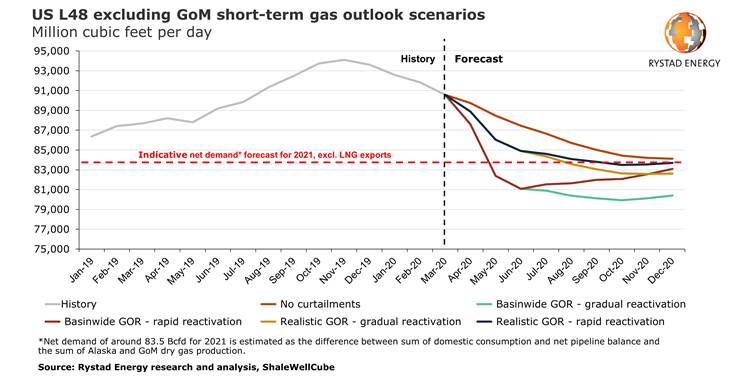US gas production set to hit bottom in November due to Covid-19-related shut-ins and drilling decline
May 19, 2020The Covid-19 pandemic has forced oil and gas producers to slash budgets and reduce drilling activity, which in the US always affects future hydrocarbon output as existing fields naturally decline. Operators also shut some producing oil fields, halting in turn their associated gas output. Rystad Energy estimates that US gas production (Lower 48 States excl. Gulf of Mexico) will reach its lowest point in November, at 82.5 billion cubic feet per day (Bcfd) before a gradual slow recovery begins in 2021.
We expect that gas production will decline every single month until November in our base-case scenario. This assumes a gradual reactivation of producing fields and is based on what curtailments we realistically see happening, rather than taking a basin-wide analogical approach. To put the decline into context: Gas production has already dropped from about 94 Bcfd in November 2019 to 88.9 Bcfd in April 2020.
Meanwhile, May’s output is expected at 86 Bcfd. After the forecasted November low, the slow recovery that we anticipate is only expected to add around 1 Bcfd by mid-2021 and 1 Bcfd more by the end of that year.
“As many oil-focused producers implement significant production curtailments, one might think that this loss will also start to affect associated gas production soon. Still, associated gas production is not declining as quickly as the market had hoped for so far,“ says Rystad Energy’s Head of Shale Research Artem Abramov.
Most of the 11.5 Bcfd year-on-year output reduction till November will occur due to natural decline. Only about 1.7 Bcfd from the total decline will happen due to shut-in curtailments.

This outlook is based on a gradual recovery of the WTI oil price towards $35 per barrel and the Henry Hub gas price towards $2.5 per MMBtu in 1H21. The production outlook is based on our analysis of company guidance, base decline assessment and the most representative type of curves. Rapid reactivation requires stable WTI prices in the range of $30 to $35 per barrel already in 3Q20.
With a full recovery in LNG and domestic demand, we expect that we will enter 2021 with supply at least 6 Bcfd to 9 Bcfd lower than what the market would like to absorb next year. We believe Henry Hub prices will be in the $2.5 to $3.0 per MMBtu range to trigger the recovery in gas basins, so they are well-positioned to balance the upcoming supply deficit.
For more analysis, insights and reports, clients and non-clients can apply for access to Rystad Energy’s Free Solutions and get a taste of our data and analytics universe.
Similar Stories
Daphne Technology and Williams secure DOE grant to advance methane emission reduction technology
Daphne Technology, in partnership with Williams, has announced the award of a grant worth nearly $6M from the U.S. Department of Energy's (DOE) Methane Emissions Reduction Program (MERP).
View Article
Solar Prize Round 8 semifinalists & power up contest winners
View ArticleBiofuel can deliver significant GHG emissions reductions but future uptake could be hampered by supply, says DNV
According to DNV’s latest white paper “Biofuels in Shipping”, key biofuels like FAME and HVO have great potential for reducing greenhouse gas (GHG) emissions and supporting compliance with maritime regulations,…
View Article
U.S. wholesale electricity prices were lower and less volatile in 2024
View Article
Blue Water enables dedicated CO2 carrier solution between Royal Wagenborg and INEOS for Greensand Future project
View Article
The eighth U.S. liquefied natural gas export terminal, Plaquemines LNG, ships first cargo
View ArticleGet the most up-to-date trending news!
SubscribeIndustry updates and weekly newsletter direct to your inbox!





